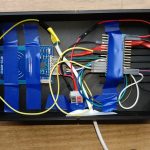
Timcon
In this project, I learned about studying abstract phenomena by using design for research. We elaborated on the side effects and the convenience of smart home products in the context of future everyday life. Our hypothesis was that there is an inevitable relationship between time and convenience when it comes to smart home products which was tested by means of Timcon. Timcon is a research artefact that replaces a regular light switch with a box that forces users to scan cards to turn on the light. Using the cards is either convenient, or time consuming. The results indicated that users won’t wait until a product is done fulfilling its task if this waiting time can be used effectively otherwise. Therefore, we concluded that smart home products succeed to save us time, but do increase our pace at the same time. Only if people change their planning and use of time, designers might be able to design products that are not necessarily faster but do increase convenience in some way.

Technology and realization
One of the key aspects of this project was the research artefact that had to be made. We first decided how the product would function and what the interaction would look like. Then, we simultaneously worked on the technical development and the design of the casing. There was also a led strip attached, which would display a gradient to indicate the time when using the master card. The case was 3D printed and didn’t need refinishing as the printer outcome was already in line with the requirements of the design. All in all, the prototype was not perfect as it wasn’t very stable and required repair mid-way through the study. However, it did look presentable and it fulfilled its purpose of collecting data to be used in interviews and further analysis. This image shows the schematic electric circuit and more on the development and technical realisation can be read in our final report.
User and society
During this project, I have learned more about (side) effects that products and designs can have on habits, expectations, society, culture etcetera. Especially in this project, the negative side effects of products designed to offer convenience are highlighted. These side effects range from increased power usage to higher pace of living. I’ve realised that extensive research in controlled or specifically chosen environments is not enough to truly get to the core of the implications a design can have. It is true that we can find empathy and understanding through research, yet it merely gives us information within the range of what the researcher and designer can oversee. As in this case, the negative side effects of smart home products on not only individuals but society as a whole, might outweigh the benefits that they are designed to supply. I find this to be a very valuable insight that might have been logical, but did change how I create and reflect on my own work.





